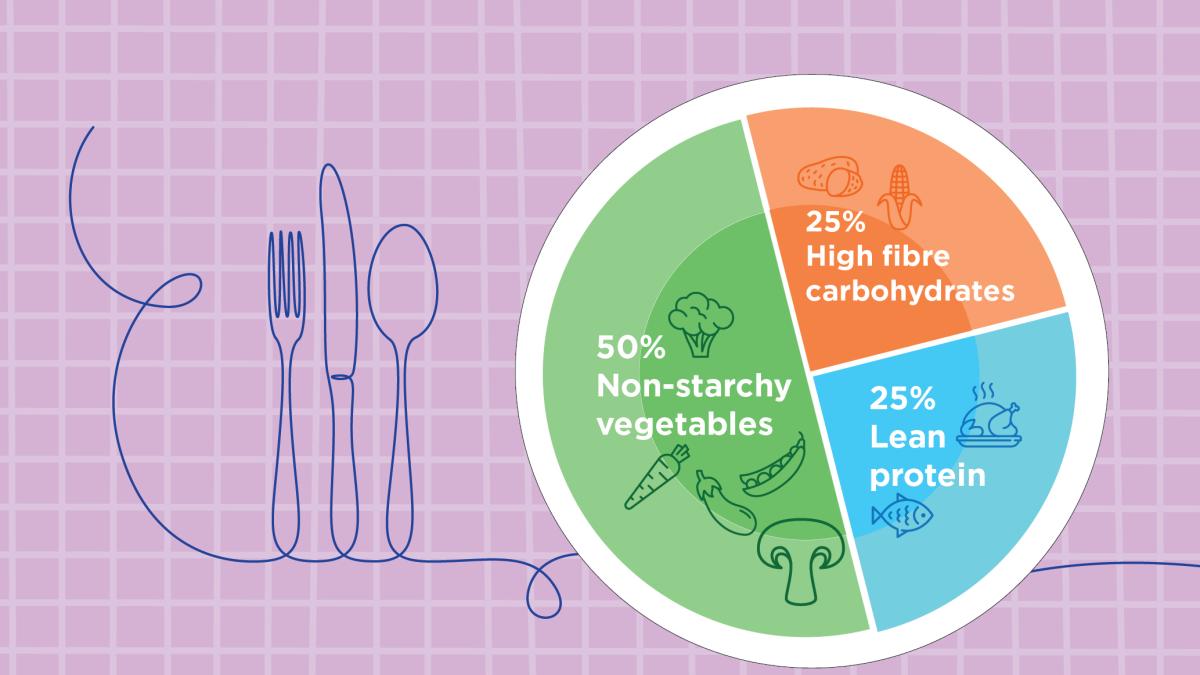Diabetes-friendly Plate Portioning Guide


This guide provides a simple, yet effective way to create balanced meals that help regulate your blood glucose levels.
The best part is, the guide is not only helpful for people with diabetes, but also for those wanting to prevent diabetes! By following these steps, you can ensure that your plate is filled with the right proportion of non-starchy vegetables, lean protein, and high-fibre carbohydrates.
Step 1: Fill half of your plate with non-starchy vegetables
Non-starchy vegetables are lower in carbohydrates, so they won't cause as much of an insulin spike. Plus, they are full of vitamins, minerals, and fibre, making them an essential part of a healthy diet.
On your plate, include a minimum of two handfuls of:
- Asparagus
- Bok choy
- Broccoli
- Capsicum
- Carrots
- Cauliflower
- Cucumber
- Eggplant
- Green beans
- Lettuce
- Mushrooms
- Peas
- Snow peas
- Spinach
- Tomato
- Zucchini
Step 2: Fill a quarter of your plate with lean protein
Lean protein is essential for strong muscles and to keep you full. Many animal-based proteins are high in saturated fat, which can increase your risk of heart disease. So, opting for lean options instead will ensure they are lower in saturated fat. For non-meat eaters, some plant-based proteins like beans and legumes are also high in carbohydrates - so it's important to be mindful of where they fit in your diet.
On your plate, include a palm size serving portion of:
- Canned tuna
- Chicken
- Edamame
- Falafel
- Hard boiled egg
- Hummus
- Kangaroo
- Lean beef cuts (porterhouse, flank, tenderloin)
- Lean mince
- Nuts and nut butters
- Prawns
- Tofu
- White fish
Step 3: Fill a quarter of your plate with high fibre carbohydrates
Carbohydrates provide energy and fibre, but they can also cause your blood glucose levels to rise if you consume too much or if you aren’t eating the best types of carbohydrates for your condition. Lower glycaemic index (GI) carbohydrates increase blood glucose levels slower than higher GI carbohydrates - so these are a better choice if you are diabetic. Low GI foods also stop you from feeling as hungry, which may help you to manage or lose weight.
On your plate, include a fist size serving portion of:
- Barley
- Chickpeas
- Corn
- Flat bread
- Pearl cous cous
- Potato
- Quinoa
- Rolled oats
- Sweet potato
- Wheat pasta
- White or brown long grain rice
- Wholegrain bread
Bonus step: Use healthy fats
Healthy (unsaturated) fats are important for lowering cholesterol levels and reducing the risk of heart disease. Cook with olive oil and add ingredients like mixed nuts and seeds or a quarter of an avocado to your plate as a source of healthy fats. A thumb-sized serving portion of oil is enough when cooking.
Following these easy steps can help you create balanced and nutritious meals that can keep your blood glucose levels in check. It's also important to note that you should consult with a registered dietitian or healthcare professional if you have any specific dietary requirements or medical conditions.
Sources -
- https://www.diabetesaustralia.com.au/living-with-diabetes/healthy-eating/
- https://www.diabetessa.com.au/Web/Education_and_Events/DiabetesSA_Resources/Healthy_Meals_Ideas.aspx
- https://www.cdc.gov/diabetes/managing/eat-well/meal-plan-method.html
- https://www.diabetesfoodhub.org/articles/what-is-the-diabetes-plate-method.html
- https://www.hopkinsmedicine.org/health/wellness-and-prevention/prediabetes-diet
- https://www.diabetesfoodhub.org/articles/create-your-plate-simplify-meal-planning-with-the-plate-method.html
- https://www.canr.msu.edu/news/diabetes_meal_plans_include_favorite_foods
- https://www.betterhealth.vic.gov.au/health/conditionsandtreatments/diabetes-and-healthy-eating
Share this article

